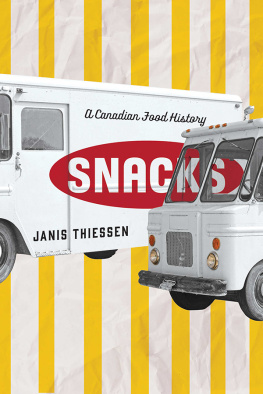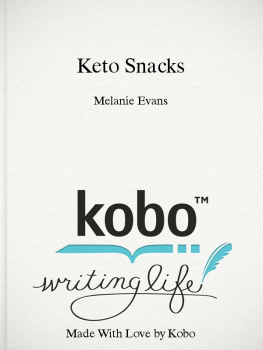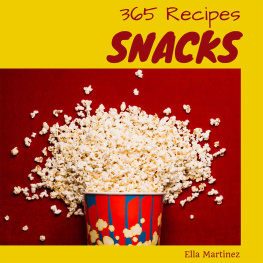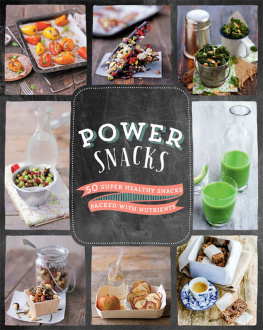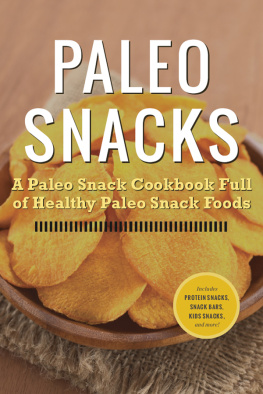Snacks
A Canadian Food History
Janis Thiessen
Snacks: A Canadian Food History
Janis Thiessen 2017
21 20 19 18 17 1 2 3 4 5
All rights reserved. No part of this publication may be reproduced or transmitted in any form or by any means, or stored in a database and retrieval system in Canada, without the prior written permission of the publisher, or, in the case of photocopying or any other reprographic copying, a licence from Access Copyright, www.accesscopyright.ca, 1-800-893-5777.
University of Manitoba Press
Winnipeg, Manitoba, Canada
Treaty 1 Territory
uofmpress.ca
Cataloguing data available from Library and Archives Canada
ISBN 978-0-88755-799-6 (paper)
ISBN 978-0-88755-529-9 (pdf)
ISBN 978-0-88755-527-5 (epub)
Cover design by David Drummond
Interior design by Jess Koroscil
Printed in Canada
The University of Manitoba Press acknowledges the financial support for its publication program provided by the Government of Canada through the Canada Book Fund, the Canada Council for the Arts, the Manitoba Department of Sport, Culture, and Heritage, the Manitoba Arts Council, and the Manitoba Book Publishing Tax Credit.
for Tim,
whose idea this was
Contents
Old Dutch Potato Chips: A Canadian Company?
The Changing Chip Industry: Potato Growers and Federated Fine Foods
Corporate Mythology and Culinary Tourism: Hardbite and Covered Bridge Potato Chips
Cheezies: A No-Growth Model
The Romance of Chocolate: Paulins, Moirs, and Ganong
Candy Manufacturers: Surviving in an Anti-sugar World
Kids Bids Television: Advertising and Child Consumers
INTRODUCTION
There is a certain amount of comfort in a bag of chips or a chocolate bar.
ANONYMOUS OLD DUTCH EMPLOYEE
Snack foods are simultaneously loved and reviled. Many of us eat themand in great quantity. But we are told they are not healthy, either physically or morally. Snacks are filled with sugar or fat or salt, each of whichrightly or wronglyhas been linked in popular discourse with a host of diseases: hypertension, diabetes, bad cholesterol, and (the most recent, and seemingly most pressing, concern) obesity. Our moral health is threatened by snacks as well. We are warned that we have replaced the cooking of raw ingredients in our homesand the consumption of the resulting meals at a table surrounded by family and friendswith the hasty and lonely consumption, in cars and on the go, of processed food substitutes filled with chemicals and produced by faceless, industrial entities.
When I was growing up, snacks were always available in my parents home. There were cases of Pic-a-Pop stacked beside the furnace in the basement: bottles of orange, root beer, and (my fathers favourite) black cherry soda. The glass bottles fit neatly into the bright orange plastic cases provided by the Winnipeg bottling company, which would pay a deposit for their return. Beside these basement Pic-a-Pop cases were accompanying stacks of boxes of Old Dutch potato chips, primarily salt and vinegar flavour. In the pantry and kitchen, my parents stocked boxes of Cracker Jack, the occasional box of Lucky Elephant popcorn (which was coated in neon pink candy), Eat-More and Kit Kat chocolate bars, and Nutty Club pearled peanuts (with their bumpy coating of red candy). The freezer contained boxes of Mackintoshs Toffee; my father preferred his toffee rock-hard and would smash it into eatable bits with his fist. The refrigerator held bags of Paulins Puffs, the chocolate-covered marshmallow cookie with a graham wafer base topped with jam: my parents liked the crack of the cold chocolate as they bit into the cookie. We got Wagon Wheels in our school lunch boxes and ate a cookie or two after our breakfast in the morning (our mother said it was important to start the day with something sweet). And buried in the bottom of my mothers sewing machine cabinet was a secret stash of candy, accessible only to her.
Snacks were much less available to my father during his own childhood. Born in 1925, he had vivid memories of the traditional brown-paper lunch bag his church distributed to children at Christmas, filled with roasted peanuts in the shell, a few pieces of hard candy, and one precious Christmas orange. During prairie summers, he would catch gophers for the government bounty of five cents per tail, spending the money on Pepsi. Decades later, he could still sing the old jingle, Pepsi Cola hits the spot! Twelve full ounces, thats a lot. Twice as much for a nickel, too. Pepsi Cola is the drink for you. But, despite this comparative paucity of snacks, his childhood diet was not necessarily healthier than mine. Typical meals included strips of deep-fried dough (known among Russian Mennonites as rollkuchen), salted and served with watermelon; bread spread with rendered pork fat (also known as crackles or jreewe); or plauten piea shallow apple pie baked on a cookie sheet (eaten as an entre, not as a dessert).
Snack Food or Junk Food?
My fathers Russian Mennonite childhood diet had much in common with that of journalist Michael Pollans mother. Pollan says she grew up in the 1930s and 1940s eating a lot of traditional Jewish-American fare, typical of families who recently emigrated from Russia or Eastern Europe: stuffed cabbage, organ meats, cheese blintzes, kreplach, knishes stuffed with potato or chicken liver, and vegetables that often were cooked in rendered chicken or duck fat.
Pollan has elaborated on his food rules, declaring, Dont eat anything your great-grandmother wouldnt recognize as food.
A quarter century before Pollans critique and Laudans defence of industrial food, anthropologist Sidney Mintz outlined the severe limitations of the pre-industrial diet and the historical dominance of sugar in the European working-class diet in his landmark book, Sweetness and Power. Mintzs careful historical work revealed the impoverishment of the great-grandmothers diets that Pollan so casually lauded. The late nineteenth-century workers diet was unhealthy and uneconomical,
Mintz, Pollan, and Laudan have brought the history of food to the attention of the general public; yet, food history is a fairly recent field of academic study. Though undertheorized at this early stage, it shows signs of providing productive insights into such broad areas as migration studies, labour history, sensory history, and the history of capitalism. Taste, according to historians Gerald Fitzgerald and Gabriella Petrick, is both something an individual possesses and something negotiated between individuals or groups; it is a dialectic relationship between producers and consumers. Contemporary criticism of snack (or junk) food consumption has ties to class as well.
Public discourse on snack food shows similarities to that on alcohol, tobacco, and drugs. Nancy Reagans dictum just say no to drugs, for example, is echoed in Pollans and New YorkTimes columnist Mark Bittmans pleas to individuals to make food choices that do not include processed foods. We need to look past this binary of choice and addiction to the lived experiences of eaters. This lived sensory experience reveals that people have chosen to eat snack foods for a variety of reasons including taste, which is shaped not just by the physiological experience of eating but also by collective memory. The labour process that results in these products, however, is acknowledged by consumers (and, too often, also by scholars) only in a superficial manner.
Telling the Story of Snack Foods
This book tells the story of independent Canadian snack food manufacturing firmstheir owners, managers, workers, and consumersin the twentieth and twenty-first centuries. A business, labour, and social history, this book examines the production, promotion, and consumption of snack foods. Industrial capitalism after the Second World War transformed Canadian society, as the manufacturing of non-essential products escalated, and postwar prosperity and increasing working hours transformed snack foods from treats to replacement or supplementary meals. In an article for

